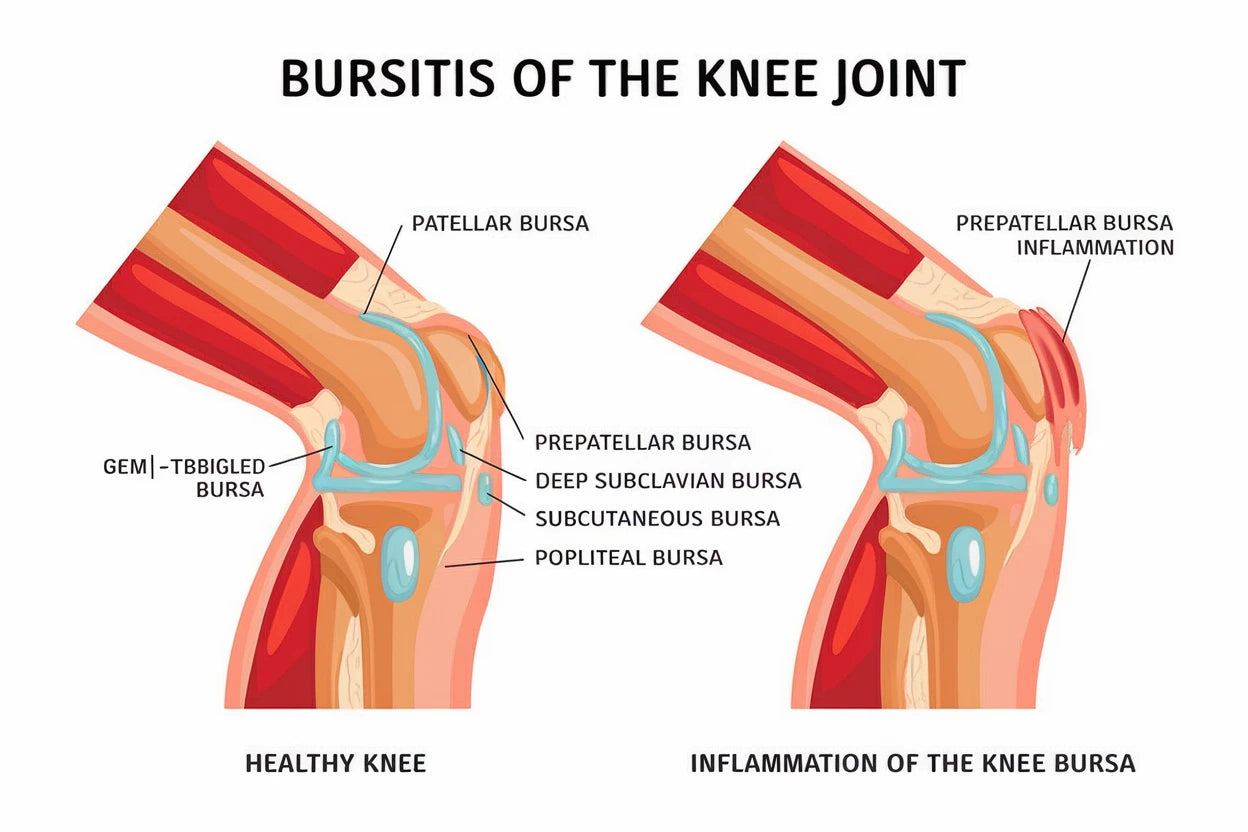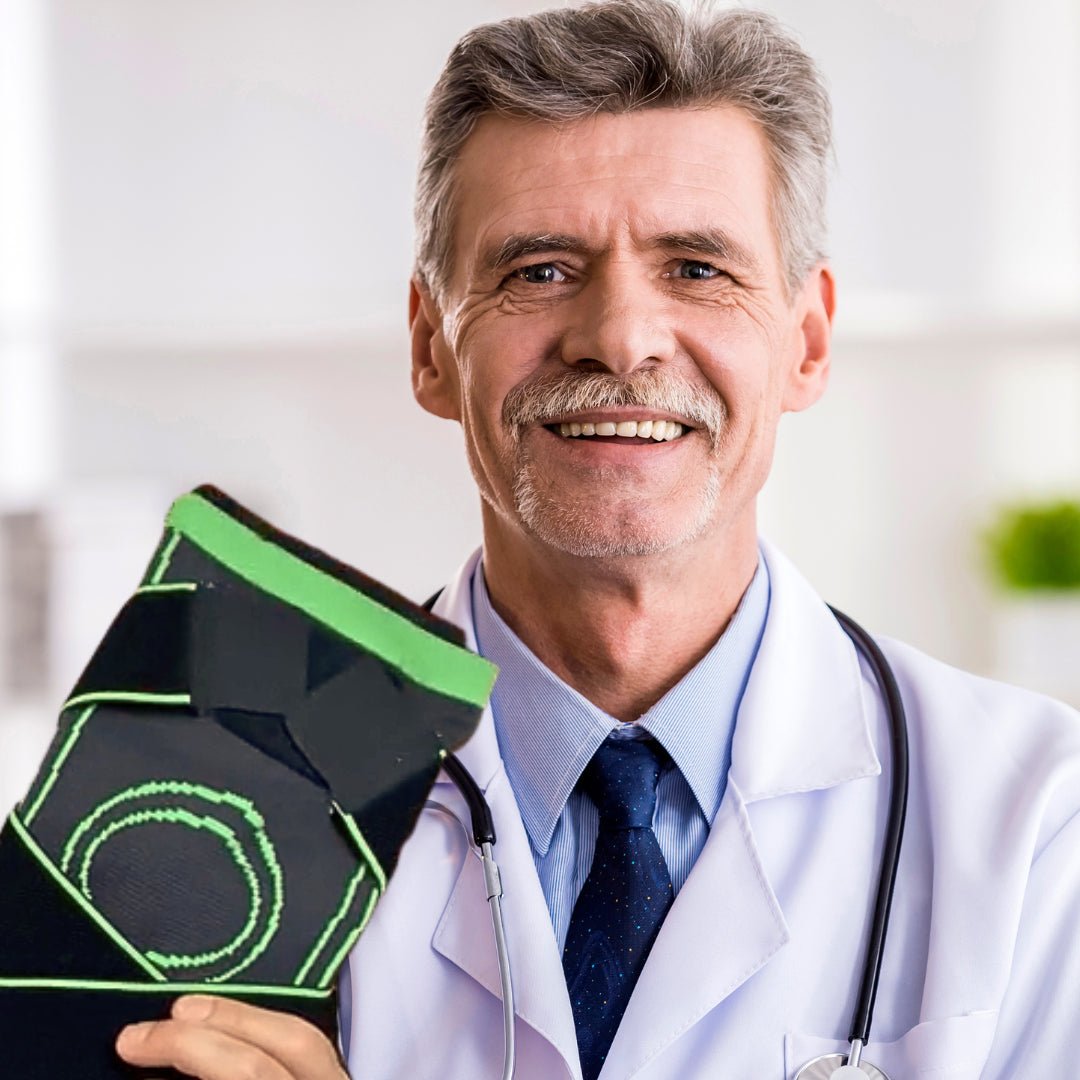Bursitis in the Knee: Symptoms, Causes, and Treatment

Knee bursitis, also known as bursitis, is a painful inflammation of one of the knee's bursae. These small, fluid-filled sacs act as shock absorbers between bones, muscles, and tendons. When they become inflamed, it can cause significant discomfort and limited mobility.
Causes of bursitis in the knee:
- Overuse or repetitive movement that puts stress on the knee
- Direct trauma or blow to the knee
- Prolonged pressure, for example from kneeling work
- Certain medical conditions such as rheumatoid arthritis or gout
- Infections (in rare cases)
Previous injuries such as osteoarthritis in the knee or meniscus injuries can also increase the risk of bursitis, especially if the injury is caused by incorrect loading over time.
Common symptoms of bursitis in the knee:
- Pain and tenderness in the knee, especially with movement or pressure
- Swelling around the affected area
- Stiffness in the knee joint
- Limited mobility in the knee
- Redness and warmth over the swollen area
- Difficulty bending or extending the knee fully
The symptoms can sometimes be mistaken for knee osteoarthritis , so correct diagnosis is important.
Diagnosis of bursitis in the knee:
Diagnosis is usually made through a combination of a physical examination and the patient's medical history. In some cases, the doctor may recommend imaging tests such as ultrasound or MRI to confirm the diagnosis of bursitis and rule out other conditions.
Treatment of bursitis in the knee:
- Rest and relieve the affected knee
- Cold therapy to reduce swelling and inflammation
- Anti-inflammatory drugs such as NSAIDs or Coxib
- Use of a soft knee pad or taping to relieve pressure on the area
- Physiotherapy and customized exercises to improve mobility and strength
- In some cases, cortisone injections may be needed for rapid pain relief. In more severe cases, fluid accumulation can be confused with other causes such as fluid in the knee , so proper imaging is crucial.

Hur KnäKomforten™ och Termoreliever™ kan hjälpa vid bursit
KnäKomforten™ är ett specialdesignat knäskydd som erbjuder riktad kompression för att minska svullnad och stödja knäleden, vilket är avgörande vid bursit (slemsäcksinflammation). Skyddet hjälper till att lindra smärtan från inflammationen samtidigt som det ger välbehövlig stabilitet och avlastning för det drabbade området under dagliga aktiviteter.
Termoreliever™ erbjuder lugnande värmeterapi som effektivt bidrar till att minska stelhet och förbättra blodcirkulationen kring den inflammerade slemsäcken. Detta kan påskynda återhämtningen och öka rörligheten i knät.
Kombinationen av dessa produkter ger både omedelbar smärtlindring och långsiktig komfort för dig som lider av bursit i knät.
Dessa hjälpmedel är ett värdefullt komplement till vila och eventuell medicinsk behandling av bursit. KnäKomforten™ med sin kompression är idealisk för att hantera svullnad och ge stöd vid rörelse under dagen. När den mest akuta inflammationen har lagt sig kan Termoreliever™ användas för att lindra kvarvarande stelhet och förbättra cirkulationen – perfekt för att mjuka upp knät efter perioder av stillasittande.
Kop nüPreventive measures:
- Avoid prolonged kneeling or repetitive movements that put stress on the knee.
- Use knee pads during activities that pose a risk of knee injuries.
- Strengthen the muscles around the knee through regular exercise
- Maintain a healthy weight to reduce stress on your knees
- Take breaks and stretch regularly during repetitive activities
Forecast:
Most cases of knee bursitis will resolve within a few weeks with proper treatment and rest. For long-term or recurring problems, additional measures may be needed. It is important to follow your doctor's advice and not return to full activity too soon, as this can lead to a return of the inflammation.
Conclusion:
Bursitis of the knee is a common but manageable condition. By being aware of the early symptoms of bursitis and seeking appropriate treatment, most people can effectively manage their symptoms and return to normal activities. Remember to listen to your body and give it time to heal for the best possible recovery.
Frequently Asked Questions (FAQ)
How do you know if you have a bursitis in your knee?
Typical signs of bursitis in the knee include pain, swelling, and tenderness over the affected area, especially with movement or pressure. The knee may feel warm and appear red. If these symptoms persist, you should consult a doctor for a proper diagnosis.
What are three symptoms of bursitis?
- The three main symptoms of bursitis are:
- Pain and tenderness in the affected area
- Swelling
Limited mobility in the joint
Can fluid in the knee go away on its own?
In some cases, mild fluid accumulation in the knee may resolve on its own with rest and self-care. However, if the fluid is caused by bursitis or other underlying conditions, professional treatment may be needed. Using KneeComfort™ can potentially help reduce swelling and promote healing.
How do you get rid of bursitis?
- Treatment for bursitis may include:
- The RICE Method (Rest, Ice, Compression, Elevation)
- Anti-inflammatory drugs
- Physiotherapy
- In some cases, cortisone injections
Use of supportive products such as Knee Comfort™ to reduce strain and promote healing
How did I cure my bursitis naturally?
Natural methods for managing bursitis may include:
- Rest and avoidance of activities that worsen symptoms
- Applying ice or heat (Thermoreliever™ may be useful here)
- Gentle stretching and strengthening exercises, after consultation with a physiotherapist
- Use of anti-inflammatory herbs or supplements (after consulting a doctor)
- Use of supportive products such as Knee Comfort™ to reduce strain on the affected bursa
Remember that while these natural methods may help, it is important to consult a doctor for a proper diagnosis and treatment plan, especially if symptoms are severe or persistent.

